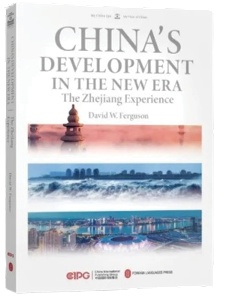
China’s Development in the New Era: The Zhejiang Experience
Written by David W. Ferguson
Price: RMB 108
Paperback, 223 pages
Published by Foreign Languages Press
Zhejiang lies on the southeast coast of China, south of the Yangtze River Delta. Bordered by Shanghai and Jiangsu Province to the north, it is one of the pioneer provinces in China’s development.
David Ferguson, a writer and editor with the Foreign Languages Press and a Chinese Government Friendship Award winner, is a long-time resident in China. He has observed the country up close and has an original, in-depth understanding of it. His new book looks at Zhejiang from the perspective of its opening up, its private economy, digital economy, and green productivity.
In 2022 and 2023, Ferguson visited various places in Zhejiang, including Yucun in Anji, the village where the concept that “lucid waters and lush mountains are invaluable assets” was first put forward; the Dachen Island, the birthplace of the spirit of reclamation; as well as the Ningbo-Zhoushan Port, and Yiwu International Trade Market.
In five chapters, Ferguson shares his thoughts on Zhejiang’s contribution to China’s sustainable development, with vivid storytelling and numerous photos.
In the preface, the author mentions an event in the early 2000s that would have a significant impact on Zhejiang. It was the appointment of Xi Jinping as secretary of the Communist Party of China’s Zhejiang Provincial Committee.
After arriving in Zhejiang in October 2002, Xi toured all the 11 prefecture-level cities and 69 county-level cities and districts across the province in 10 months. Then on the basis of these extensive investigations he formulated a new development plan for Zhejiang – the Double-Eight Strategy – which covered eight key areas and proposed a set of measures for each.
Besides economic development, it also addressed social, environmental, and cultural development, reflecting a critical stage in China’s national development strategy – a shift away from economic development at all costs to a development approach that would give equal emphasis to social and environmental factors.
Ferguson visited some representative private enterprises in Zhejiang, for example, Geely and e-commerce giant Alibaba. He says the province prospers as its private economy prospers.
The geographical strengths and the benefits from the opening up are also discussed. Zhejiang’s mercantile tradition means that it has always been one of China’s leading provinces in foreign trade. It has direct economic and trade relations with more than 220 countries and regions.
Ningbo in northeast Zhejiang, at the tip of Hangzhou Bay, has served as a port since extensive seafaring began in the Tang Dynasty (618-907). Zhoushan is Zhejiang’s smallest prefectural-level city, an archipelago off the east coast of Ningbo. Both Ningbo and Zhoushan have extensive deep-water port facilities. The Ningbo-Zhoushan Port is the largest oil and iron ore transport hub in China, and a major hub of coal, grain and container cargoes. It is the third-largest port globally by container throughput and the largest by tonnage of goods handled.
The environment is at the heart of the province’s development strategy. The Qiantang River, stretching 612 kilometers from its source to the Hangzhou Bay estuary, is Zhejiang’s largest river. Its former name, the Zhejiang, literally “crooked river,” gave the province its name.
Moganshan is a township lying at the foot of the Mogan Mountain. Although it was October when Ferguson went there, the trees were still lush green and reminded him of alpine villages in summer, giving him the feeling that he could be in Austria, France, or even Switzerland.
Culture and history-wise, Zhejiang is one the cradles of the Chinese civilization, known as the home of silk and the land of fish and rice, and renowned for its cultural heritage. Its West Lake, Jianglang Mountain, Liangzhu Archaeological Site, and the Grand Canal flowing through it are all on the UNESCO World Heritage List.
Zhejiang is also the birthplace of China’s ancient southern operas. Zhejiang’s Yue Opera is one the most influential local operas in China. Tang Xianzu (1550-1616), the great Ming Dynasty (1368-1644) playwright, once served as a county magistrate in Zhejiang. His masterpiece, The Peony Pavilion, is a classic Chinese drama. The Wuzhen Theater Festival, an annual event in the water town of Wuzhen, has gained worldwide recognition.
In addition, the province has 241 items recognized as national intangible cultural heritage, including Dongyang woodcarving, Qingtian stone-carving, and Wenzhou’s Ou sculpture. And 11 items are on UNESCO’s Intangible Cultural Heritage List, including traditional sericulture and silk craftsmanship, wooden movable-type printing, and traditional designs and methods for building wooden arch bridges.
The book ends with the village of the future in Zhejiang. Waitongwu in the hills on the outskirts of Hangzhou is essentially a tea-growing village and a major producer of West Lake longjing tea. The village has two economic pillars, its traditional tea farming and its new role as a center of cultural enrichment, with the Waitongwu Gallery and Exhibition Center playing a leading role in that. Waitongwu has transformed from a rural area into a modern village, converting its tradition into valuable cultural heritage.
If asked to sum up Zhejiang in one word, Ferguson would use the word “orderly.” The cities, towns, and villages are spacious and clean, and the buildings are of good quality. The agricultural land is well-tended and the historical sites are carefully conserved and well-managed.